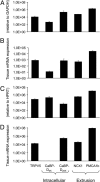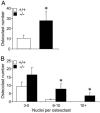The epithelial Ca2+ channel TRPV5 is essential for proper osteoclastic bone resorption
- PMID: 16291808
- PMCID: PMC1297662
- DOI: 10.1073/pnas.0505789102
The epithelial Ca2+ channel TRPV5 is essential for proper osteoclastic bone resorption
Abstract
Bone remodeling involves the interplay of bone resorption and formation and is accurately controlled to maintain bone mass. Both processes require transcellular Ca(2+) transport, but the molecular mechanisms engaged remain largely elusive. The epithelial Ca(2+) channel TRPV5 is one of the most Ca(2+)-selective transient receptor potential (TRP) channels. In this study, the functional role of TRPV5 in bone was investigated. TRPV5 mRNA was expressed in human and murine bone samples and in osteoclasts along with other genes involved in transcellular Ca(2+) transport, including calbindin-D(9K) and calbindin-D(28K), Na(+)/Ca(2+) exchanger 1, and plasma membrane Ca(2+)-ATPase 1b. TRPV5 expression in murine osteoclasts was confirmed by immunostaining and showed predominant localization to the ruffled border membrane. However, TRPV5 was absent in osteoblasts. Analyses of femoral bone sections from TRPV5 knockout (TRPV5(-/-)) mice revealed increased osteoclast numbers and osteoclast area, whereas the urinary bone resorption marker deoxypyridinoline was reduced compared with WT (TRPV5(+/+)) mice. In an in vitro bone marrow culture system, the amount of osteoclasts and number of nuclei per osteoclast were significantly elevated in TRPV5(-/-) compared with TRPV5(+/+) mice. However, using a functional resorption pit assay, we found that bone resorption was nearly absent in osteoclast cultures from TRPV5(-/-) mice, supporting the impaired resorption observed in vivo. In conclusion, TRPV5 deficiency leads to an increase in osteoclast size and number, in which Ca(2+) resorption is nonfunctional. This report identifies TRPV5 as an epithelial Ca(2+) channel that is essential for osteoclastic bone resorption and demonstrates the significance of transcellular Ca(2+) transport in osteoclastic function.
Figures








References
-
- Hoenderop, J. G. & Bindels, R. J. (2005) J. Am. Soc. Nephrol. 16, 15-26. - PubMed
-
- Bronner, F. (1998) J. Nutr. 128, 917-920. - PubMed
-
- Hoenderop, J. G., Van Der Kemp, A. W., Hartog, A., van de Graaf, S. F., Van Os, C. H., Willems, P. H. & Bindels, R. J. (1999) J. Biol. Chem. 274, 8375-8378. - PubMed
-
- Peng, J. B., Chen, X. Z., Berger, U. V., Vassilev, P. M., Tsukaguchi, H., Brown, E. M. & Hediger, M. A. (1999) J. Biol. Chem. 274, 22739-22746. - PubMed
-
- Montell, C., Birnbaumer, L., Flockerzi, V., Bindels, R. J., Bruford, E. A., Caterina, M. J., Clapham, D. E., Harteneck, C., Heller, S., Julius, D., et al. (2002) Mol. Cell 9, 229-231. - PubMed
Publication types
MeSH terms
Substances
LinkOut - more resources
Full Text Sources
Other Literature Sources
Molecular Biology Databases
Miscellaneous

